Polyester and microfiber are both widely used fabrics for a variety of textiles. Polyester is used mainly for clothing, but can also be used for blankets, bedclothes, and other household items. Microfiber is used mostly in household fabrics, such as bed sheets, pillow covers, towels and cleaning clothes. But is one of these fabrics a better choice for certain items?
The main difference between microfiber and polyester is that microfiber is 2 times thinner than polyester. Polyester and microfiber are both synthetic fibers. This means that they are made in a factory and engineered to have certain characteristics. Both are inexpensive, fairly durable, and easy to care for.
In this article, we’ll provide you with more detailed information about each of these two fabrics. We’ll look at the characteristics of both fabrics, the pros and cons of each, and which products to buy for each material. Continue reading to learn more.

Is Polyester Microfiber?
Before we discuss the characteristics of each fabric, it’s important to note that despite a few small differences, polyester and microfiber behave much in the same way. This is because they are both made of similar synthetic fibers.
Polyester refers to a larger group of fibers that are used to make the fabric. Microfiber is a specific type of polyester fiber. So fabrics that are labeled as “microfiber” are technically made of polyester. That’s why the two fabrics behave so similarly.
What sets microfiber apart is that the polyester fibers are a lot finer, making microfiber fabric more delicate and softer than polyester fabric. Some microfiber products are made of 100 percent polyester, while others are made of a blend of polyester and another synthetic fabric, usually nylon. Microfiber is a type of polyester fabric, but microfiber and polyester aren’t the same.
Polyester vs Microfiber: Key Points
When choosing fabrics or deciding what is the best fabric to use for a particular project, there are several characteristics to take into account. You will want to consider:
- Breathability
- Durability
- Softness
- Warmth
- Ease of Care
- Cost
- Uses
As an example, blankets can be made out of polyester or microfiber. Let’s say that you want to make a blanket, but you don’t know which fabric to use. You will want to consider the breathability and warmth of polyester vs. the breathability and warmth of microfiber. You should also consider the softness of the two fabrics.
While both fabrics are very similar, there are some minor differences between the two. We’ve made this chart as a quick reference for each characteristic of these two particular fabrics. We will go more in-depth about each characteristic later in the article.
| Polyester | Microfiber | |
| Breathability | Not as breathable | More breathable |
| Durability | More durable, resistant to shrinking | Less durable because of finer fibers |
| Softness | Stiffer | Softer |
| Warmth | Warm | Warm |
| Ease Of Care | Easy, avoid high temperatures | Easy, wash with other microfiber, dry on low heat |
| Cost | Inexpensive | Inexpensive |
| Uses | Clothing, sportswear, bedding | bedding, towels, cleaning cloths |
What is Polyester Fabric?
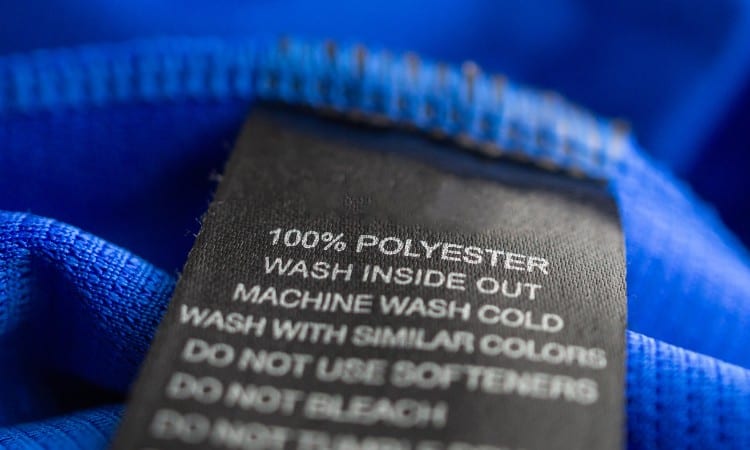
We’ve already mentioned that polyester is a synthetic fabric, but where did it come from? What exactly is it made of and how is it made?
Polyester was invented in 1941 by two British chemists named John Whinfield and James Dickson. It didn’t become extremely popular until the 1970s, where it was advertised as a “miracle fiber” due to its stain and wrinkle-resistance. But to this day, many people dislike polyester because they think it is cheap, uncomfortable, and unsafe.
Polyester doesn’t refer to a certain type of fiber. Polyester fibers are made up of polymers, which makes them a type of plastic. The chemicals that make up the polymers are derived from coal, petroleum, or other fossil fuels.
The polyester fibers themselves are very thick and strong. They are large fibers that are woven together very closely, making the fabric very durable and keeping dirt and stains from penetrating the fibers. Polyester has the qualities that it has because it is made to be that way.
What is Microfiber Fabric?
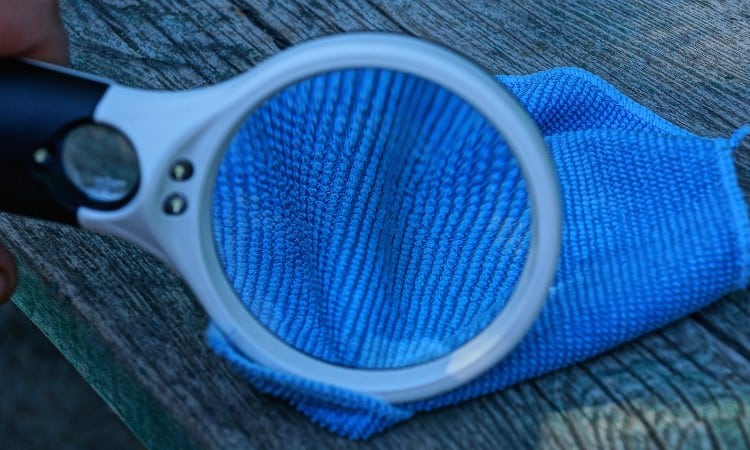
Microfiber is a synthetic fabric that is mostly made from polyester but sometimes has nylon blended with the polyester. It is called microfiber because the polyester is used to make it thinner than normal polyester fibers. Microfibers are around the same size as silk fiber, if not smaller.
Most accounts about the origin of microfiber say that it was invented by Japanese scientists for use in swimwear around the 1970s, but the fabric became too heavy when it was wet. Around the 1980s, microfiber was redeveloped to be absorbent but not heavy and marketed for cleaning purposes.
Microfiber fabrics are made by pushing the fibers through a pipe. Heat is used to fuse them, then the fibers are split into smaller microfibers. The size of microfibers can vary. The size of the fibers determines what they are used to make, which is why the fabric of some microfiber products looks different than others.
Microfiber vs Polyester: What’s the Difference?
Breathability
Both polyester and microfiber have some level of breathability, but microfiber is more breathable than polyester. Polyester is a lightweight fabric, but the close weave of the fibers doesn’t trap moisture. While polyester isn’t super breathable, the moisture-wicking qualities prevent the fabric from being weighed down with sweat and water. This is why polyester is so popular for sport and activewear.
Microfiber is slightly more breathable than polyester because the fibers are a lot finer but not as closely woven. Microfiber is a good choice for bed sheets because it keeps the person sleeping from getting too hot due to its breathability. However, it doesn’t wick away moisture as well.
Durability
Polyester is one of the most durable fabrics out there because it is made to be durable. It is resistant to wrinkling, shrinking, and stains. If taken care of properly, polyester fabrics are known to last a very long time.
Microfiber is made up of smaller fibers, so it isn’t as durable as polyester. More care has to be taken to ensure that the durability of microfiber lasts, but since it is made of polyester, it still has a high level of durability.
Softness
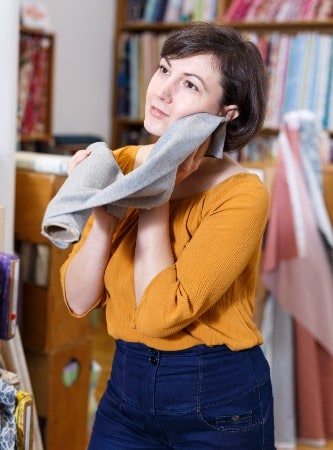 The thicker fibers that make up polyester fabric can sometimes give the fabric a stiffer feel. It may feel a little scratchy, especially when it is new or has never been washed, but it may soften up after being washed a few times.
The thicker fibers that make up polyester fabric can sometimes give the fabric a stiffer feel. It may feel a little scratchy, especially when it is new or has never been washed, but it may soften up after being washed a few times.
Thinner and more numerous fibers make microfiber softer than polyester.
Microfiber is so soft that it can sometimes have a silky feel, but the fabric may start to feel rough without proper care.
Warmth
Both polyester and microfiber are very warm. While polyester can feel cool to the touch, it actually traps air very well and keeps it from circulating. Microfiber doesn’t feel cool to the touch, but t’s softness aids in its ability to trap air inside. Both fabrics can hold in heat very well, but sheets made from microfiber are known to keep you warm while you sleep.
Ease of Care
Both polyester and microfiber are easy to care for, but there are some specific precautions to take with each fabric. Polyester fibers can become damaged when exposed to high temperatures, so you should avoid washing it using hot water and drying it using high heat. Since microfiber is also made of at least some polyester fibers, you should take the same precautions when washing it.
The best way to care for polyester is to wash it using the normal cycle setting on your washing machine. Wash it in either warm or cool water. Polyester is very shrink-resistant, but since it can’t tolerate high heat, you should allow it air dry or dry it in the dryer using low or medium heat.
Microfiber requires a little more extra care to maintain its quality and softness. Most microfiber is also lint-free, so try to wash only with other fabrics that are made of microfiber. This will keep lint and threads from sticking to your microfiber cloths. You should also wash using cool or warm water. Using gentle detergent and washing on the gentle cycle will help keep the fabric soft. Microfiber is not as shrink-resistant and can’t tolerate high heat, so you should let it air dry or dry it in the dryer using low heat.
Cost
Microfiber and polyester are both very cheap fabrics. Synthetic fabrics are generally cheaper because they are mass-produced in factories using chemicals. Their availability makes them very inexpensive.
Polyester is cheaper than microfiber. Although microfiber isn’t expensive, it does cost more than polyester because of how it’s made. Compared to natural fabrics like cotton and linen that aren’t as quickly produced, microfiber is very cheap.
Uses
Polyester is one of the most widely used fabrics there is because it is inexpensive and durable. Almost anything can be made from polyester or a polyester blend. There are blankets, towels, bedding, and other household items that are made from polyester, but the most common use is for clothing. It’s not unusual to see shirts, socks, coats, and caps that are made from polyester, especially those that are designed for activewear.
Microfiber is mostly used in household fabrics. Two of the most common uses are bedding and cleaning cloths. The softness and lint-free quality of microfiber make it great for cleaning surfaces because it won’t scratch them or leave behind a residue. Microfiber is also used a lot for towels and blankets.
Pros and Cons of Polyester
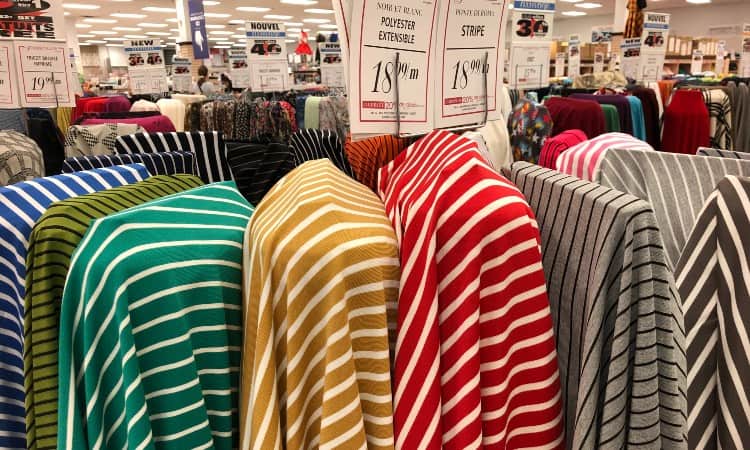
Even though it is a very common and popular fabric, there are pros and cons to polyester. We’ve already discussed the durability, affordability, and ease of care, but there are other pros as well, including:
- Moisture-wicking abilities
- Stain resistance
- Shrink/wrinkle resistance
These qualities make polyester a good choice for clothing fabrics that are put through a lot of wear and tear.
However, there are some cons to polyester as well. These cons are the reason why some people prefer other fabrics polyester. The cons are:
- Polyester is less breathable than microfiber
- It is somewhat flammable due to the chemicals used to make it.
- It can’t tolerate high heat.
- It is synthetic.
- It isn’t as soft as other fabrics.
If you prefer fabrics made of natural fibers like cotton, silk, or linen, then polyester may not be the best choice.
Pros and Cons of Microfiber
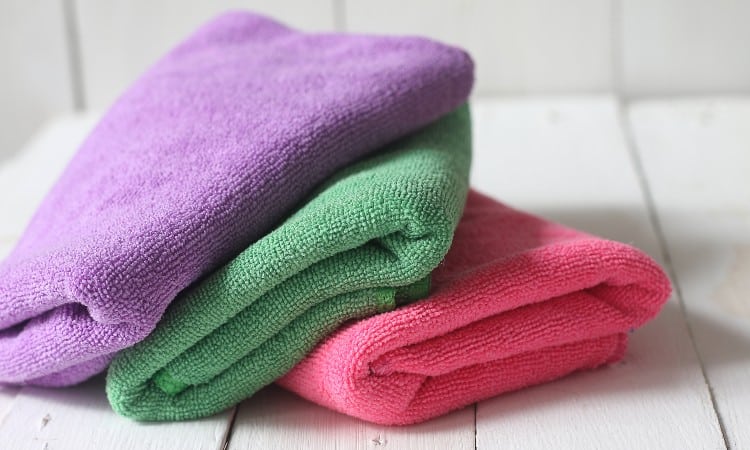
Many of the pros that polyester has also pertain to microfiber. It is durable, affordable. and easy to care for. Some bonus pros are that microfiber is:
- Easy to clean
- Absorbent
- Warm
- Soft
Polyester isn’t absorbent of moisture, but microfiber is. That is one reason why microfiber is a great fabric choice for towels and other clothes.
Some of the cons of microfiber are similar to polyester. It can’t tolerate high heat and it is a synthetic fiber, so it may not be a good choice if you prefer natural fabrics. Some other cons are that microfiber:
- Wrinkles more easily than polyester
- Can shrink some
- Has more delicate fibers
All of the above cons mean that you have to be a little more careful when washing and drying microfiber so that it doesn’t shrink. If you plan on letting it air dry, you should also remove it from the washer as soon as it finishes washing to prevent wrinkles.
Popular Products Made of Polyester and Microfiber
Polyester Moisture-Wicking Long Sleeve Tee
 This long sleeve tee is made of 100% polyester and is ideal for participating in various sports or activities.
This long sleeve tee is made of 100% polyester and is ideal for participating in various sports or activities.
The fabric wicks away moisture so that it dries faster when you sweat, exercise in the rain, or get the shirt wet in some way. The tee also is made to resist odors.
The shirt comes in eight different colors. It is available in sizes ranging from S to XXL. It can be washed in the washing machine, which makes caring for this shirt very easy.
Brushed Microfiber Bed Sheet Set
 These 1800 thread count microfiber sheets are comfortable, breathable, and soft. The sheets will keep you warm or cool, depending on the season. These sheets are easy to clean and come in a variety of colors. They are also fade and shrink resistant.
These 1800 thread count microfiber sheets are comfortable, breathable, and soft. The sheets will keep you warm or cool, depending on the season. These sheets are easy to clean and come in a variety of colors. They are also fade and shrink resistant.
This particular sheet set comes with a fitted sheet, flat sheet, and two pillowcases. They are available in sizes ranging from twin to California king and work well for use in any room in your home or even while camping.
Is Microfiber Safe?
As with most synthetic fibers, there are concerns over the safety of microfiber. While finished microfiber products are relatively safe for the user, the concerns come in during the manufacturing of the fabric.
Synthetic fibers are usually made of some kind of plastic. Plastic is made of petroleum and other chemicals that give it the qualities that it has. Some of the chemicals that are used to make microfiber and polyester are known to be toxic, especially in their pure form or when they are burned.
A lot of the chemicals are also carcinogens. This leaves many people to worry about the safety of the people who work in the factories that make microfiber. Factories are supposed to have safety regulations to limit exposure to these chemicals, but they aren’t 100 percent foolproof.
Another major concern is the harm to the environment that may result from producing microfiber. The hazardous waste and pollution from the chemicals used have the potential to be released into the environment, which can produce long-term effects.
While the safety of microfiber is usually called into question, all synthetic fabrics that are produced this way pose the same risks to the health of humans and the environment.
Should You Buy Polyester or Microfiber?
If you’re still indecisive about whether you should buy polyester or microfiber products, know that it depends on the product you’re buying. If you’re buying fabric for a project, you should ask yourself what the purpose is of the item you’re trying to make. That will help you to decide what the best material for that project is.
The same thing is true for products that you buy. Consider what you’re going to be using the item for. For example, if you are purchasing bed sheets, but you don’t like for them to be stiff and scratchy, then microfiber is best.
However, if you get hot while you sleep, sweat, and don’t mind a little stiffness, then polyester sheets are a better option for you. Microfiber will absorb moisture and is slightly warmer. The cool feel of polyester won’t make you as hot, and if you do sweat, polyester will wick it away.
Conclusion
We hope you found this article helpful for distinguishing between polyester and microfiber. Microfiber is made of polyester, so the two fabrics are very similar and have only a few minor differences. Overall, both are very affordable and durable, so it depends on what you want to use them for. If you enjoyed the article, share it with others and leave a comment. Thanks for reading!
Anna
Thursday 19th of August 2021
I need to polish my stained woodwork. The cleaner/polish says to use a lint free cloth. Can I use a microfiber cloth to apply this cleaner/polish. Is a microfiber cloth LINT free?
fatgans
Thursday 19th of August 2021
Yes, microfiber cloth is lint free.